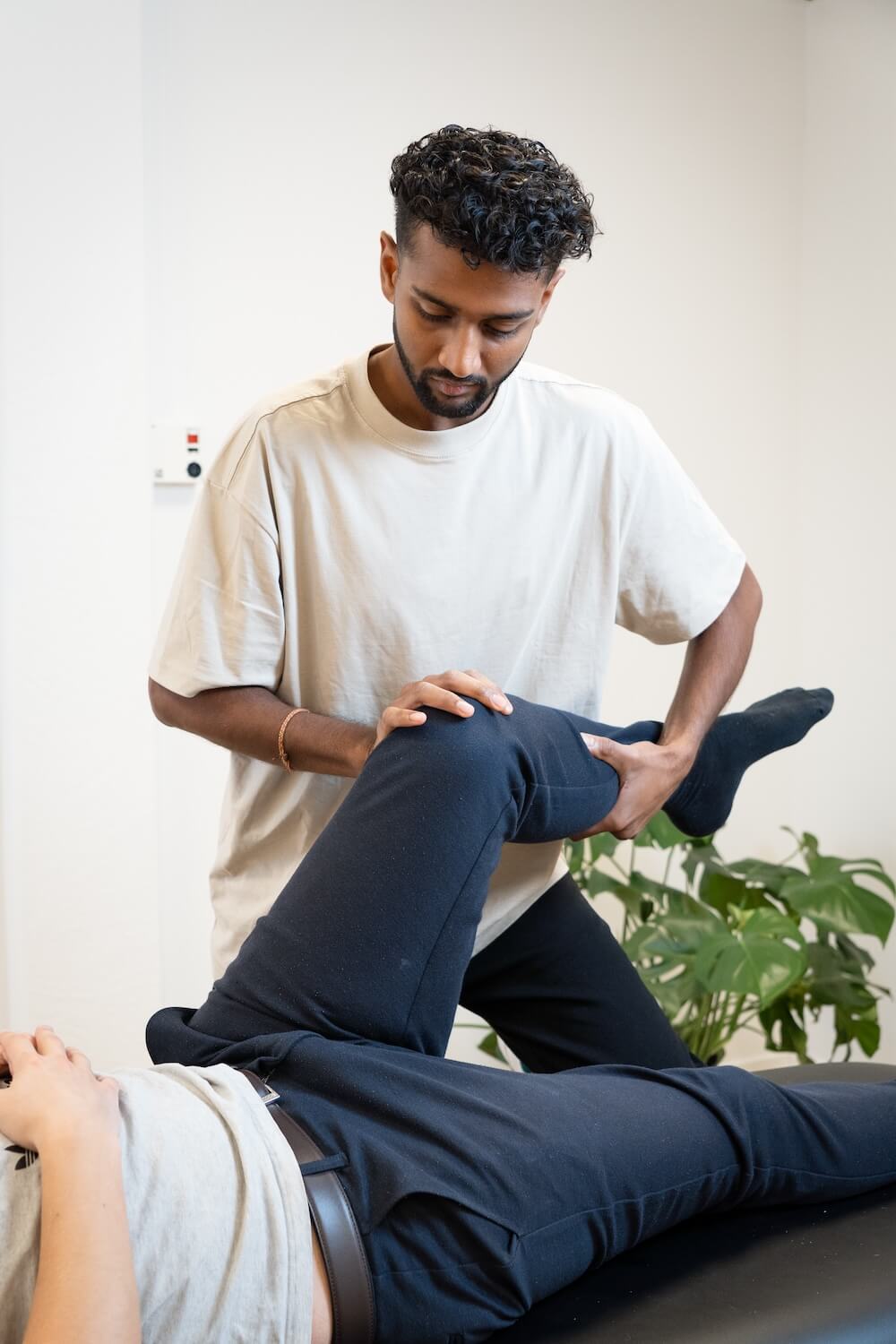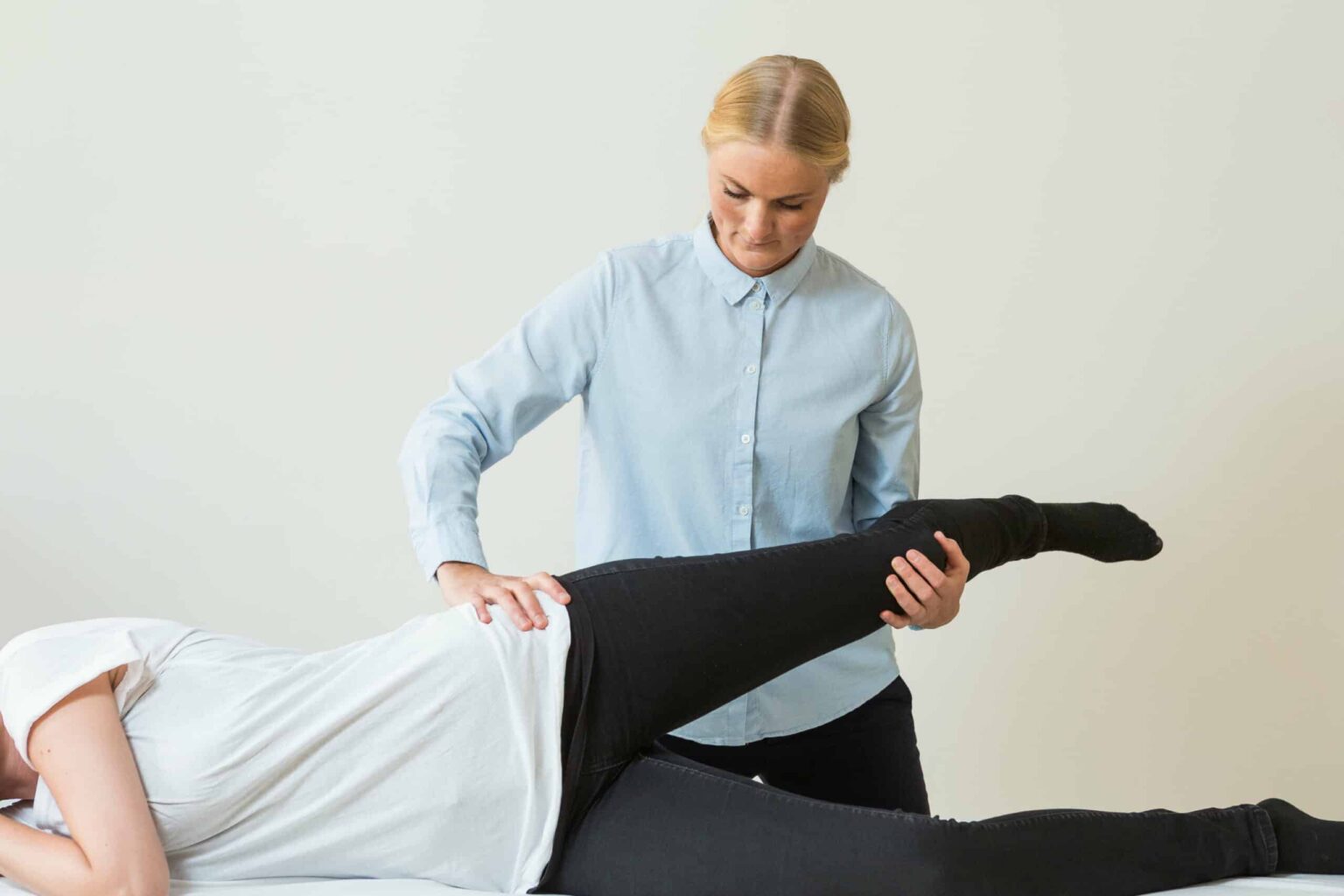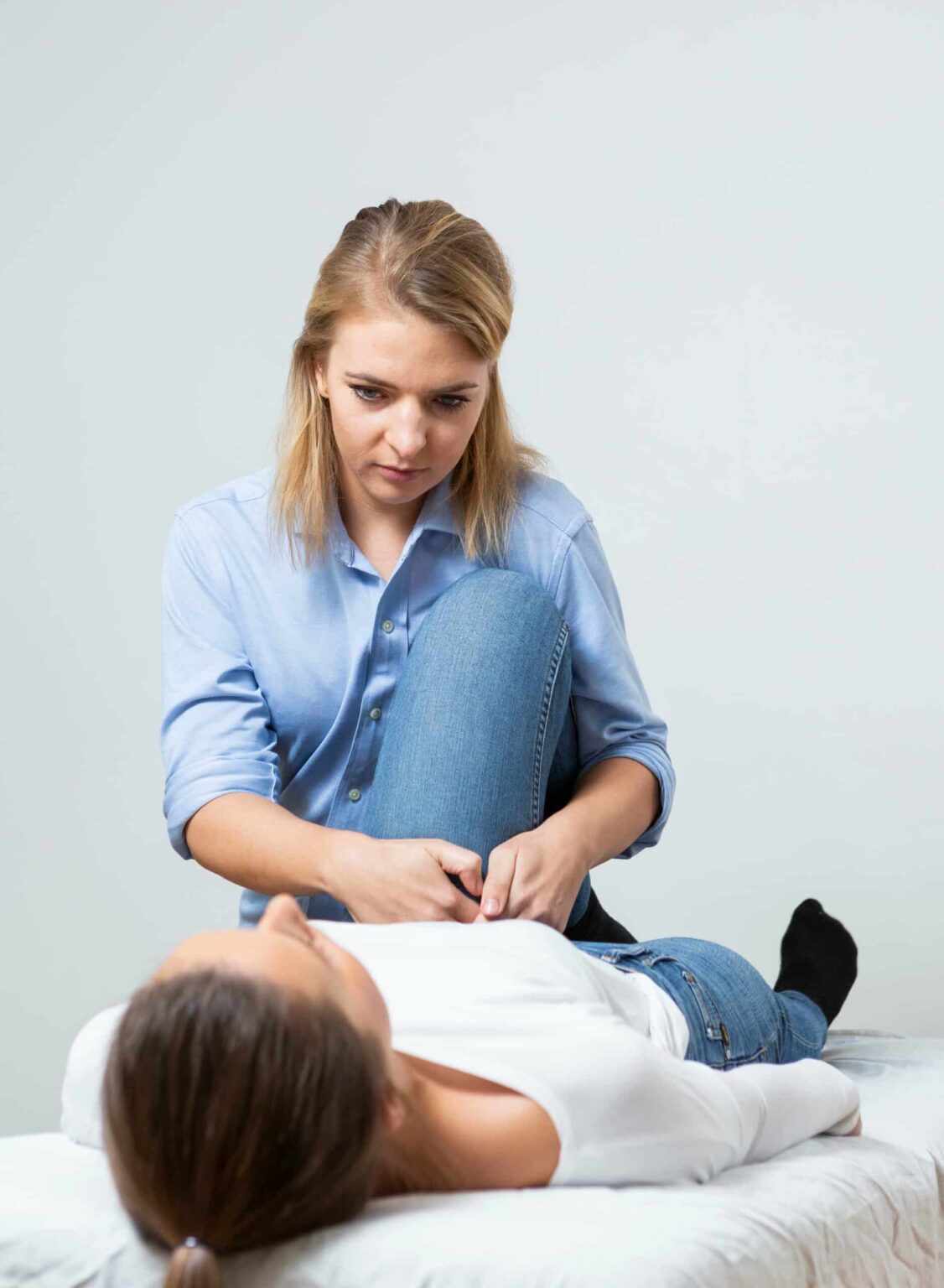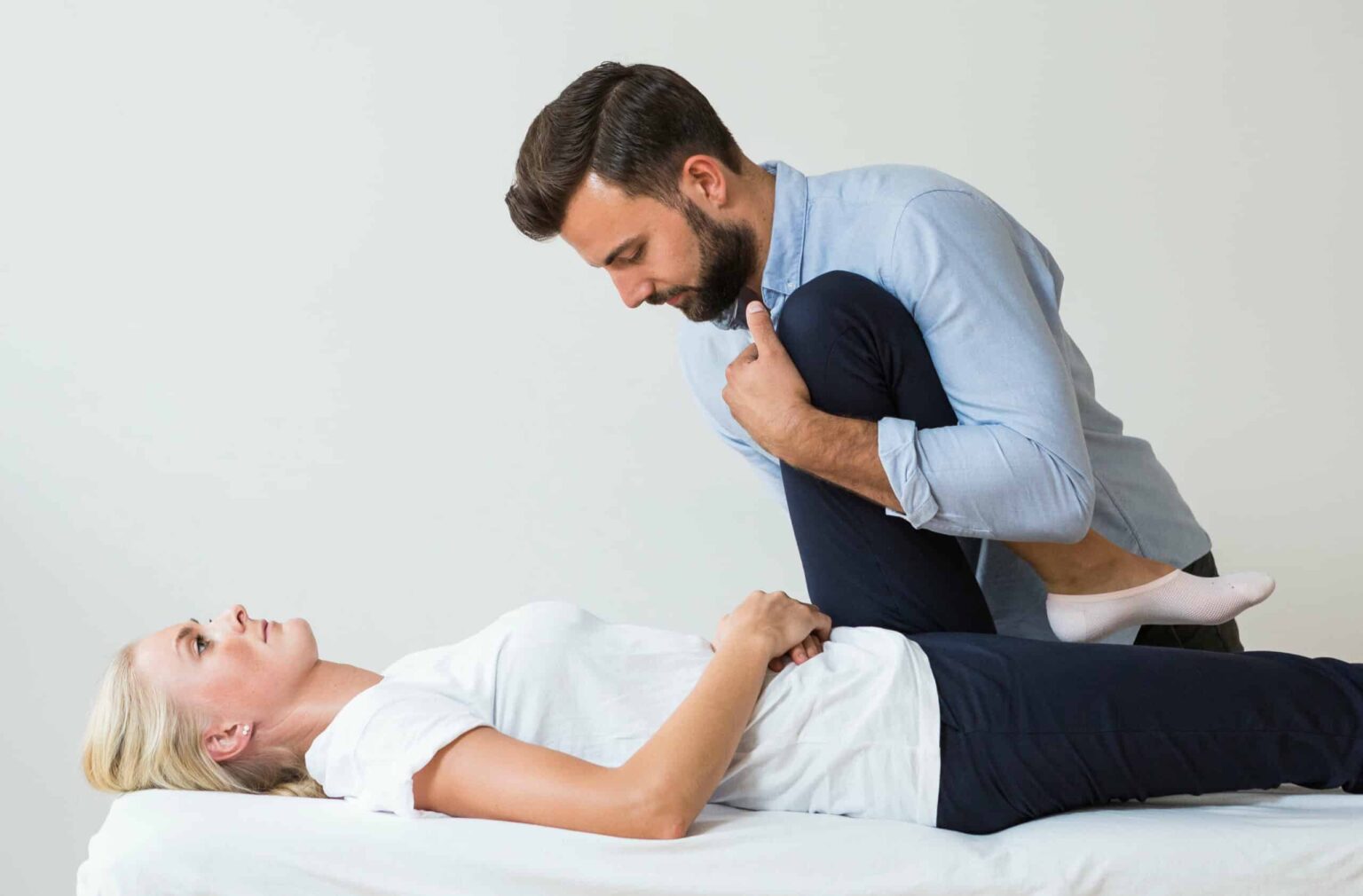We treat
Hip impingement
Learn more about hip impingement
What is hip impingement?
Hip impingement is a condition where you may experience pain deep in the groin and/or hip, primarily located in the front. Long-term groin pain is one of the most common reasons why younger people seek help from their general practitioner.
Jump to section [Vis]
Symptoms of hip impingement
Pain associated with hip impingement is typically seen with the following activities:
- Getting in and out of the car
- Squatting or standing up from a squat
- If the leg is rotated in front of the body
- Longer periods of sitting still
- Bending forward
The pain will most often slowly increase in the hip/groin region over time, and can also be experienced as strong stabbing pains deep in the groin.
Source: Sundhed.dk

Anatomy of the hip
The hip joint consists of the femoral head (caput femoris) and the acetabulum. The acetabulum is surrounded by an expanding ring made of cartilage (labrum). The cartilage ring/labrum is intended to enlarge the acetabulum, so that the load via the femur can be spread over a larger area. The cartilage that surrounds the acetabulum is ½ – 1 cm deep, and helps to create negative pressure in the hip joint.
The hip joint is very stable, but can also move in six different directions. Stability is ensured by both the capsule, ligaments and tendons passively, while large muscle groups ensure stability of the hip joint during movement/activity.
Source: Physio-pedia.com
Different types of hip impingement/ causes of hip impingement
There are 3 different types of hip impingement, all three of which are often referred to as Femuroacetabular impingement:
- CAM: In CAM, there is a bone growth on the neck of the femur bone. The bone growth can squeeze the cartilage at the hip socket, which can lead to inflammation in the area with associated pain.
- Pincher: In pincher, there is bone growth on parts of the hip socket, which thereby enlarges the socket. The bone growth on the hip socket results in the femur and the cartilage of the hip socket abutting each other.
- CAM and pincher: In CAM and Pincher, there is both an enlargement of the hip socket and a bone growth on the femoral neck. Most often, the pinching occurs on the front of the hip.
Source: Sundhed.dk and Hopkinsmedicine.org

Causes of hip impingement
There are both congenital and developmental causes of hip impingement.
Congenital causes are most often due to the hip socket being enlarged, causing the hip socket and femur to bump against each other when the hip is bent; this is described above as pinching.
Development-related causes will most often be bone growth on the femur as described above as CAM.
Source: Aleris.dk
Hip impingement test
Clinical test (FADIR test) for hip impingement is performed in the supine position. The knee is brought up towards the chest and from there towards the opposite shoulder, further down into a stretched hip again.
A positive test will be pain when the knee is rotated towards the opposite shoulder.
Treatment and advice for impingement
If you experience pain in your hip or groin, it is always a good idea to seek professional help.
The treatment will initially consist of training/exercises to strengthen the muscles and ensure stability around the hip. Furthermore, the treatment will consist of guidance with the aim of reducing pain in daily life.
Despite the biomechanical diagnosis of CAM/pincer, it is possible for patients to live without hip pain.
Squat and hip impingement
Squatting can cause pain during the movement. In some cases, the pain can be relieved by standing wider with your feet and rotating both knees outward, as this creates more space around the hip/groin.
Good advice for hip impingement
- Individually planned training, possibly with a physiotherapist.
- Adjustment of activity level may be necessary for a period of time.
- In the event of severe pain, it may be relevant to reduce the amount of pain-triggering activity and replace it with either less pain-provoking activity, or to provide more rest and recovery for a period of time.
- If you are overweight, it may be relevant to reduce the amount of strain on the joint through weight loss. In this case, it is important to have a realistic plan for weight loss and a plan for maintaining it.
Source: Hopkinsmedicine.org

Hip impingement surgery
Conservative treatment in the form of exercise and treatment will often be the first choice, as one wants to reduce invasive treatment in the form of surgery.
In hip impingement surgery, an attempt is made to repair or remove damaged tissue. For example, bone growth on the femoral neck will be removed if it is squeezing the cartilage around the socket. If the labrum/articular cartilage is only damaged, this will be sewn back together where possible.
Pain, functional level and quality of life are often improved after this type of surgery. However, normal conditions in the hip will not be restored.
Source: Aleris.dk and Regionshospitalet-horsens.dk
Osteopathic treatment
Osteopathic medicine emphasizes the connection and cooperation of the whole body. Therefore, we will look at the reason why it has arisen and what the triggering factor could be, so that you will be able to prevent it.
The treatment will consist of looking at the entire body, both mechanically, for example, the foot, ankle, knee, hip, lower back, etc.
In addition, the organ system and digestion are looked at. This is because it encourages optimal blood supply, thereby improving healing. It will also optimize the nervous system so that it is not overworked, so that the muscles and connective tissue will not be in the same state of tension. This creates an overall picture of the body’s function and condition. In addition to this, the social/emotional and psychological stressors will be looked at. This involves how you feel on a daily basis, whether you are pressured at work, socially or have some family problems that are taking up a lot of your time.
This is to gain insight into your and your body’s ability to handle everyday life, the injury, healing, movement, etc. It’s all connected, so the purpose is to create as good a picture of the whole person as possible in order to make a plan and advise as best as possible. This advice could involve everything from exercises, tools for managing stress levels, sleep, etc.





